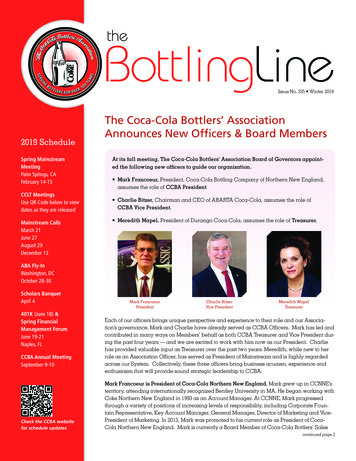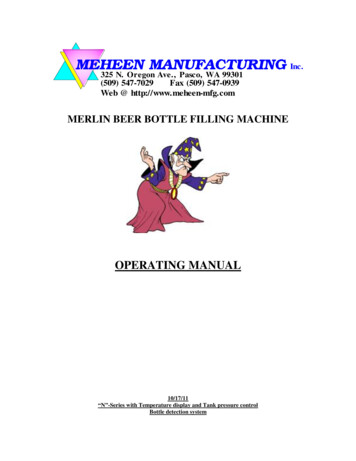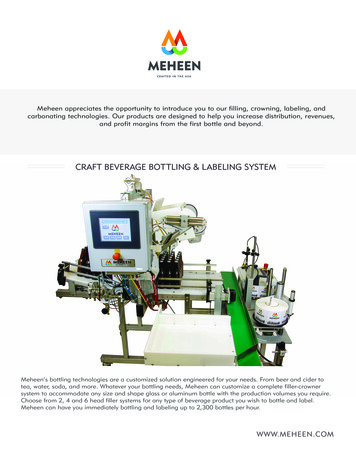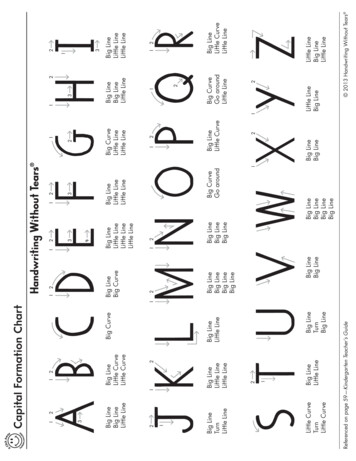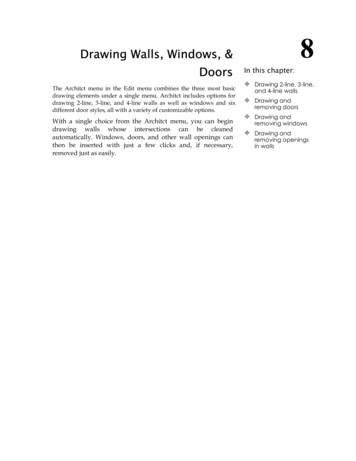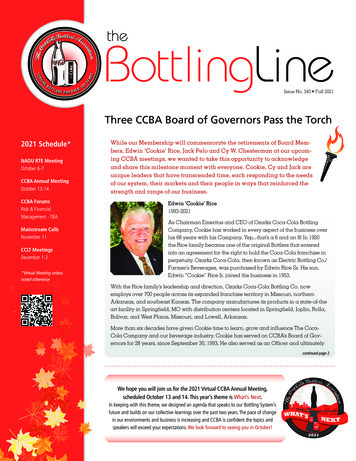
Transcription
theBottlingLineIssue No. 343 Fall 2021Three CCBA Board of Governors Pass the Torch2021 Schedule*NAOU RTE MeetingOctober 6-7CCBA Annual MeetingOctober 13-14CCBA ForumsRisk & FinancialManagement - TBAMainstream CallsNovember 11CCLT MeetingsDecember 1-2*Virtual Meeting unlessnoted otherwiseWhile our Membership will commemorate the retirements of Board Members, Edwin ‘Cookie’ Rice, Jack Pelo and Cy W. Chesterman at our upcoming CCBA meetings, we wanted to take this opportunity to acknowledgeand share this milestone moment with everyone. Cookie, Cy and Jack areunique leaders that have transcended time, each responding to the needsof our system, their markets and their people in ways that reinforced thestrength and range of our business.Edwin ‘Cookie’ Rice1993-2021As Chairman Emeritus and CEO of Ozarks Coca-Cola BottlingCompany, Cookie has worked in every aspect of the business overhis 68 years with his Company. Yep.that’s a 6 and an 8! In 1920the Rice family became one of the original Bottlers that enteredinto an agreement for the right to hold the Coca-Cola franchise inperpetuity. Ozarks Coca-Cola, then known as Electric Bottling Co./Farmer’s Beverages, was purchased by Edwin Rice Sr. His son,Edwin “Cookie” Rice Jr. joined the business in 1953.With the Rice family’s leadership and direction, Ozarks Coca-Cola Bottling Co. nowemploys over 700 people across its expanded franchise territory in Missouri, northernArkansas, and southeast Kansas. The company manufactures its products in a state-of-theart facility in Springfield, MO with distribution centers located in Springfield, Joplin, Rolla,Bolivar, and West Plains, Missouri, and Lowell, Arkansas.More than six decades have given Cookie time to learn, grow and influence The CocaCola Company and our beverage industry. Cookie has served on CCBA’s Board of Governors for 28 years, since September 30, 1993. He also served as an Officer and ultimatelycontinued page 2We hope you will join us for the 2021 Virtual CCBA Annual Meeting,scheduled October 13 and 14. This year’s theme is What’s Next.In keeping with this theme, we designed an agenda that speaks to our Bottling System’sfuture and builds on our collective learnings over the past two years. The pace of changein our environments and business is increasing and CCBA is confident the topics andspeakers will exceed your expectations. We look forward to seeing you in October!
Three CCBA Board of Governors Pass the Torch(.continued from page 1)as President of The Coca-Cola Bottlers Association in 2009-2010. Cookie’s contributions to CCBA andour Coca-Cola System resulted in his being designated by his fellow Bottlers as a Living Legend, whenCCBA celebrated its 100th anniversary in 2013!Cookie also served on the Board of Directors for the Coca-Cola Scholars Foundation, and the American Beverage Association. His retirement from the CCBA Board is effective upon the conclusion of its Fall Board meeting in September.Jack Pelo1996-2021Like Cookie, Jack grew up in the Coca-Cola System. He learned the business from theinside by working in the warehouse, on the bottling line, running special events and inalmost every job for his family’s Bottling company in Walla Walla, Washington. CCBC ofWalla Walla sold to Swire Coca-Cola in 1988. After that acquisition, Jack joined Swire asthe Northwest Division Manager and continued to drive growth and gain valuable industry insight. He accepted the role of Swire’s President and CEO in 1996, the same year thathe was elected to the Board of Governors for The Coca-Cola Bottlers’ Association. Jack hasbeen an influential advocate for his fellow Bottlers, a key member of numerous committeesand projects and has played a powerful role in transforming our nation’s beverage industry. Jack served as President of The Coca-Cola Bottlers’ Association in 2003-2004, and Chairman of both the AmericanBeverage Association and The Coca-Cola Scholars Foundation. He also bears distinction as ‘first-ever’ Bottler CoChair of the System Leadership Governance Board (SLGB). Jack’s leadership extends beyond our Coca-Cola system,where he serves on the Advisory Board of the Federal Reserve Board of San Francisco, and on the board of directorsfor Swire Cold Storage, Key Technology, Inc. and Western Container Corporation.While Jack has already retired from his position as President and CEO of Swire Coca-Cola USA, we now reachanother milestone as he officially retires from CCBA’s Board of Governors. When he joined the CCBA Board of Governors 25 years ago and became President and CEO, Swire Coca-Cola USA employed approximately 1,600 peopleacross several states. With Jack’s leadership, Swire Coca-Cola USA has grown to 7,200 employees in 13 states thatstretch between the Mexican and Canadian borders and from the Pacific Ocean to the plains of Nebraska.Cy Chesterman1998-2021Cy W. Chesterman hails from a Coca-Cola Bottling family that is currently five generations strong. Technically, the Chesterman family has been in the beverage business longerthan The Coca-Cola Company! (But that’s a story for another day.) Chesterman Company,based out of Sioux City, Iowa is independently owned and operated, producing and supplying quality beverages for the markets they serve since 1872.Cy guided his family’s move in 1977 to their current headquarters location in Sioux City,where they still produce, bottle, and distribute a wide variety of products across their franchise. Shortly thereafter he led the company as it began production of canned beverages,acquired additional franchise territories in Nebraska, South Dakota, and Illinois and expanded into the bottled waterbusiness, establishing Premium Waters, Inc. Like Cookie and Jack, the years pass quickly when you love what youdo. Cy’s two sons Cy Jr. and Jay Chesterman have joined him in the family business, focusing on Coca-Cola, whileCy continues to run Premium Waters. Cy has participated on the CCBA Board of Governors for 23 years.The Chesterman Company’s territory includes parts of Iowa, Nebraska, and South Dakota and employees approximately 800 people.continued page 32
Three CCBA Board of Governors Pass the Torch(.continued from page 2)At this time CCBA also welcomes Sally Hargis, Ozarks Coca-Cola and Rob Gehring, Swire Coca-ColaUSA to its Board of Governors. Sally and Rob’s election to the Board was formally confirmed at the FallBoard Meeting in September.Sally is vice president and chairwoman for Ozarks Coca-Cola Bottling Company. AsCookie’s daughter, Sally is carrying on a 100-year family legacy at Ozarks Coca-Cola. Shebelieves that the company’s focus on valuing people over profit has helped their businesscontinue to thrive for a century and grow significantly over the past three years. Sally alsoserves on the CoxHealth Systems board of directors in Springfield, MO.Rob joined Swire Coca-Cola USA in 2018 and is a veteran of theCoca-Cola system and a former Global Chief Sales Officer forThe Hershey Company. At The Coca-Cola Company, Rob servedSally Hargisas President of the Walmart Global Team, as well as several otherroles within the Coca-Cola system including Vice President of Sales in the Canadian andWestern U.S. business units.Rob will carry forward the tremendous work done by Jack over the past decades and bringhis experience and knowledge to the Association.We know you join us in thanking Cookie, Jack and Cy for their leadership and serviceon the CCBA Board of Governors. Each has offered a unique perspective with industryknowledge and expertise and will be missed.Rob GehringWe look forward to working with Sally and Rob!Coca-Cola Scholars Foundation Board UpdateWe are pleased to formally announce that Angela Harrell, SVP, ChiefDiversity & Corporate Responsibility Officer, Voya Financial, andPresident, Voya Foundation and Pamela Stewart, President, WestOperations North America Operating Unit, The Coca-Cola Companywere elected to the Board of the Coca-Cola Scholars Foundation earlierthis year.Angela D. HarrellAngela is also a 1991 Scholar and worked with The Coca-Cola Companyfor 12 years before joining Voya in 2014. Pamela has served in key leadership roles with Coca-Cola for 20 years, serves on several communityboards and councils and has been the recipient of numerous national andlocal honors and awards.We congratulate Angela and Pamela on this distinction! You can learn more about The Coca-Cola Scholars Foundation’s leadershipby scanning the codePamela Stewart3
Your Family Owned BusinessThe Five Fundamental Building Blocks of Strong Family BusinessesBy Dana Telford, The Family Business Consulting GroupBusiness activities are often compared to sports. The analogy is straightforward. Sporting eventstake place in arenas, where coaches field their best players to execute their strategies. The goal isto win. Business owners follow a similar pattern, organizing and assembling leaders and employees to charge boldly into competitive marketplaces. The goal is to make profit.Before competing in a new sport, one must first learn the basic set of skills – the fundamentals– that are the foundation for success in the arena. When a team loses, its coaches often adjusttheir training and practices and refocus on the fundamentals. In American football, the fundamentals are called blocking and tackling. In baseball, fielding and hitting. In basketball, dribbling,shooting and rebounding. Without proficiency in these basics, it is hard to imagine that any teamwould achieve victory in the arena.I believe there are five fundamental building blocks of family business that must be learned andconsistently revisited in order to give the business the best chance for success.1. Aligned OwnersOwners who are not aligned consume precious energy and resources as they try to wrestle each other into agreement. Here’s an example: Two branchesof a family in Latin America each owned 50% of a 500 million manufacturing company. Annual free cash flow was 75 million. The leaders of eachbranch disliked and distrusted each other, for many decades. Their most recent disagreement was about how to distribute profits. Many hours of manydays for many months were spent trying to convince the other side to alter their point of view. Each time a proposal emerged and alignment seemedimminent, attorneys were called in for final document reviews. New arguments emerged, and the cycle continued for three years. The real disagreement?One branch wanted an 18% profit distribution and the other 20%, a difference of 1.5 million. Split in half and after taxes, this amounts to less than 400,000 per family, not including legal and consulting fees. Was it worth the time and resources expended?A better investment of irreplaceable time and energy would be to work to reach agreement on the six essential alignment questions:1. Purpose: Why are we in business together? (e.g. we believe our family business is a force for good in our community and we are its stewar2. Goal: What are we trying to accomplish? (e.g. a statement of owner’s alignment or becoming the best place to work in our city)3. Core Values and Code of Conduct: How will we treat each other and make decisions? (e.g. guiding principles, rules of communication,calendaring meetings)4. Accountability: Who is involved, what are their respective roles and responsibilities, and to whom they will be accountable for their activities?5. Metrics: How will we define and measure success? (e.g. culture and employee satisfaction surveys, revenue growth, profitability, return onequity, risk, distribution, productivity)6. Timeline: When will we work on becoming aligned? When will we reach alignment?If alignment is not met within the timeline and if little to no progress has been made, a logical question to respectfully consider is whether the family isthe right owner for the business. Would it not be wiser to liquidate or go through a shareholder buyout rather than continue to try to convince or coercethe other side?2. Effective Board of Advisors/DirectorsThe evolution of board governance in family businesses is predictable. Early stage entrepreneurial companies often have what are colloquially known asrubber stamp boards. They exist on paper but don’t really function as intended. As owners and businesses evolve, so do their boards. Advisory boards areoften put in place prior to a transition of the business from the founder to siblings. Advisory boards might include family members and two or three nonfamily outsiders.Fiduciary boards are more formalized and have a legal responsibility to protect the interests of the shareholders and ensure that the business is managedwell from both a legal and financial perspective. In fact, each owner has the same fiduciary responsibility to all other owners, a point not often consideredwhen selling or gifting shares to children or other family members.continued page 54
Your Family Owned Business(.continued from page 4)The board has four primary responsibilities. First, to understand and protect the interests of the shareholders. Second, to understand the company’scompetitive strengths and work with management to set a strategy that leverages them. Third, to oversee and hold management accountable for the successful operations of the company. Fourth, to plan for continuity through ownership and leadership succession planning.How well a board fulfills its responsibilities, be it advisory or fiduciary, relies on three main factors:1) how clearly its purpose and function is defined by the shareholders, 2) how talented and engaged its directors are, and 3) how well it is led. As familybusinesses evolve, it is crucial for family shareholders to understand and pay close attention to establishing and maintaining an effective board. A highfunctioning board can provide great value to shareholders and help them to pursue an authentic, compelling vision.3. Strategic PlanningIn athletics, talent and hard work go a long way, but champions aren’t crowned without extensive competitive knowledge. In business, enterprises startwith a belief that a product or service will be valuable to someone. This belief leads to the pursuit of identifying that someone – the ideal customer. Next,business leaders must understand what key activities they can provide better than their competitors. Fusing those two pieces together – understandingwhere a company’s strength will be most well received and valued in a service or product offering – that is where competitive advantage lies.As an example: a client in the restaurant business knows that their strengths lie in efficiently and graciously serving more guests per day (called tableturns) than their competitors. With this knowledge in hand, they make choices about how they decorate their properties, prepare their food and train theirstaff members. These choices are designed to help them win and keep the customers who will value them the most. As an example, they don’t have televisions in their bars and restaurants. Why? The television watching customer is most often male, tends to dine and watch alone and is prone to continuewatching until a sporting event is completed. He slows the cycle of operations and hinders the restaurant from leveraging its competitive advantage ofhigher than market table turns.As a result, the owners and managers focus their investment of resources in developing facilities and training that appeals to the dining out female. The“date night decision maker” one might say. A customer who tends to place more value in the ambience, the subtle beauty of the décor, the graciousnessof the servers and the high quality of the food.4. Merit-Based LeadershipFamilies must find the most talented leaders to operate their businesses, regardless of their position in or connection to the family. In the fable of “TheGoose and The Golden Egg,” greed and a lack of critical thinking leads a countryman to destroy his unique animal. With careful thought and planning, asuccessful business family can avoid a similar fate. Why is the Golden Goose so valuable? It lays golden eggs. Eggs (benefits) that the family can use toprovide for their needs and support them as they pursue their life’s objectives. Keeping the goose healthy and strong is the most logical collective effortthe family should undertake. Rather than worry about who gets to control the goose, the most important question to answer is: Who is the most talentedgooseherd? (Yes that’s really what it’s called!)The two most essential questions in family business succession are 1) Does any member of the next generation have the desire to lead the company?and 2) Can she or he lead as well or better than a non-family leader? If the answer to either question is “No,” a non-family leader must be identified andhired. These simple questions are often forgotten in the emotion and competition that accompanies succession.A former client is a successful entrepreneur and a world-class athlete. When he and I first got to know each other, I asked him about his children. Did theypursue sports in college like he had? Yes. Had any of them achieved athletic success to the same level as he had? No. When I asked him why he thoughtthey had not excelled he said, “They are talented kids but they just didn’t love their sport like I did. And still do. The love of the game fuels you to workharder than anyone else at turning your talent into on-the-field superiority. Desire unlocks the door for greater success. But ultimately it is your talent thatopens the door and gets you into the biggest arenas.”If members of the next generation have the sincere desire to lead the family business, how can current leaders judge their abilities objectively? Based onour 25 years of advising business families, we have identified two critical elements in this process. First, the family must develop and distribute a familyemployment policy that defines its strong commitment to merit-based company leadership. Second, the owners must put together a focused, well-runboard of directors/advisors, with family and non-family directors, and lean heavily on them as they strive to identify and hire the most talented leaders.continued page 65
Your Family Owned Business(.continued from page 5)5. Engaged Family GovernanceMost family businesses fail to transition to the next generation. From founder to siblings and siblings to cousins, the failure rate is over 65%. Why? Onemight guess that company leadership or strategy-related issues might be the culprit, such as lack of access to growth capital or inadequate strategicknowledge. Years of solid research from numerous credible institutions shows that, in over 60% of cases, the underlying reason for a failed transition isfamily dynamics and conflict. Disagreements about a vision for the future, strategies for growth, who should lead, accountabilities, compensation, sharedfamily assets, standards for family employment, how to make decisions together and how to manage interpersonal conflict – they all create a palpablelevel of tension. Without appropriate governance, this tension will naturally escalate into enough turmoil that will lead family members to choose to disengage and pursue individual professional paths.Taking the time to envision, create and maintain a system of family governance will benefit every family business. No two family governance systemsshould be exactly alike because no two family businesses are exactly alike. Start by identifying a team of at least three family members who share a desireto perpetuate the family business legacy. Have them pick a leader from among them. Encourage them to set a two-year calendar with half day meetingsevery six – eight weeks (or more often if there is more urgency). Give them the mandate to work together and with other family members to answer thesix essential alignment questions identified earlier in this article (see 1. Aligned Owners), but this time from the family’s perspective.And finally, excellent governance comes down to excellent communication. Excellent communication is Clear, Respectful, Authentic, Consistent. It’s arguably the single most important piece of family business success. So, CRAC the code for excellent communication.Execute the Game PlanJust as in the world of competitive sports, family business owners must master and consistently practice the fundamentals if they are to remain successful.Whether you and your family are rookies in the world of governing your business or seasoned professionals; continuous improvement through practice isthe key. Any family will benefit from a consistent and thorough review of these fundamental areas.As an idea for doing so, in your next family meeting, have each participant work together to complete the following: Write down and create a personal priority list of the five fundamentals. Compare each other’s priorities, explore and discuss each other’s reasoning, listen to each other with a goal of understanding eachother’s unique perspective. Tally the scores and determine the collective priorities of the group. Take out personal calendars and, using a two-year timeline, pick one day every quarter to focus on each one of the fundamentals.Begin with priority one, end with priority five. Through discussion, assign one person to be accountable for each fundamental. Agree to the expectation that those who are accountable for each fundamental will lead the preparation for and management of the meeting.Articles purchased or downloaded from The Family Business Consulting Group are designed to providegeneral information and are not intended to provide specific legal, accounting, tax or other professionaladvice. Since your individual situation may present special circumstances or complexities not addressed in thisarticle and laws and regulations may change, you should consult your professional advisors for assistancewith respect to any matter discussed in this article. The Family Business Consulting Group , its editors andcontributors shall have no responsibility for any actions or inactions made in reliance upon information contained in this article. Articles are based on experience on real family businesses. However, names and otheridentifying characteristics may be changed to protect privacy.The copyright on this article is held by The Family Business Consulting Group . All rights reserved. Articles may be available for reprint withpermission. To learn more about using articles for your publication, contact editor@thefbcg.com.6
Coke Florida Named 2021 Nintex InnovationChampionNintex, the global standard for process management and automation, announced 18 winners of the 2021 NintexSolution Innovation Awards, and Coca-Cola Beverages Florida, LLC (Coke Florida) achieved top honors.For successfully automating business processes across its departments and operatinglocations in the state of Florida with Nintex capabilities, Coke Florida was named 2021Nintex Champion, the highest recognition given to a Nintex partner. By leveraging thefull Nintex Process Platform for process management and automation, including process mapping, workflow automation, RPA, and more, Coke Florida has quickly mapped,managed, and optimized workflows across all of its operations improving efficiencyand supporting the company’s growth.Coke Florida also implemented solutions on the Nintex Process Platform to ensure thesafety and security of its employees, vendors, and customers, a critical capability duringthe COVID-19 pandemic.The Coke Florida Technology and Enterprise Transformation team recognizes the value of automation in innovation and began usingNintex Workflow for Office 365 and Nintex Workflow Cloud in 2018 to integrate disparate assets and processes.Scan the QR code to learn more about Coca-Cola Beverages Florida’s digital transformation powered by Nintex Coca-Cola Beverages Florida Names Thomas N. Benford Presidentand Chief Operating OfficerThomas was promoted from Executive Vice President and Chief Commercial Officer in April, as the last issue of TheBottling Line was printing! In his new role, Thomas will oversee end-to-end commercial operations including planning, customer management, field sales, product supply, risk management, sustainability, and facilities management.He joined Coke Florida in 2015, at its founding, as Vice President of Strategy and Planning.Mr. Benford’s career includes tenure with the Halliburton Company, where he served in Marketing and Developmentand Corporate Finance roles. Prior to Halliburton, he was an Investment Banking Analyst in the leveraged financegroup at J.P. Morgan Chase. Thomas holds an MBA from Harvard Business School and undergraduate degrees inEconomics and Computational and Applied Mathematics from Rice University.We know our Members join CCBA in congratulating Thomas!”40 Under 40” in AlaskaLessie Kincaid, VP of Sales, Coca-Cola Bottling of Alaska / The OdomCorporation, Anchorage was included in The Alaska Journal of Commerce’s annual list of the 2021 Top Forty Under 40. These are the topyoung professionals in the state who exemplify excellence in professionaland community service.We know you join us in congratulating Lessie on this distinctive honor!7
A Family Legacy ContinuesOzarks Coca-Cola recently celebrated 101 years as a family-owned and operated businessAND formally unveiled its multimillion-dollar headquarters expansion!The overhead connector is designed to transport product cases across andinto an area with two palletizers that automatically stack the cases. Palletsare then taken into the warehouse space to await loading onto trucksheaded to Ozarks Coca-Cola’s customers. The bridge itself is not designedfor people or employee traffic, except for maintenance, repairs or relatedwork on the conveyor belt that links manufacturing to storage.The Ozarks family ownership with timeline of the Company history behind themOn May 15, Ozarks Coca-Cola Company officials, employees and invitedguests gathered to cut the ribbon celebrating their 432,000-square-footexpansion to the Company’s location on N. Packer Road. This 22 millionexpansion is located just behind the Company’s existing manufacturingbuilding with the two facilities connected by a special bridge that spansJordan Creek. (CCBA Members may recall viewing the incredible dronefootage of the facility in our previous issue of The Bottling Line.) Thenearby Jordan Creek is a landmark resource and currently the focus of amultimillion-dollar revitalization project by the city of Springfield, Missouri.The first phase of Ozarks Coca-Cola’s expansion began in 2018, when thedesign stage for its manufacturing facility started with an 18 million investment that focused primarily on a new blow-in molding production line.This new line offers a strategic way to manage production expenses, whileincreasing volume capabilities. The new warehouse has grown from theoriginal facility’s eight loading docks to forty-two (42)! President and COOBruce Long said the warehouse expansion gave the company a chance toconsolidate operations and created space for the additional productionline. “It gives us the opportunity and space to produce more for otherBottlers, to operate more efficiently, and to have the room to work and tobring all of our departments under one roof,” Long said.Vice President and Board Chairperson Sally Hargis shared the challengethat company officials addressed when they planned their expansion. Sallyexplained, “We had significant manufacturing growth at the main plant,and we needed a bigger warehouse. The creek, however, was still there andhad to be considered. Jordan Creek is pretty important to Springfield, andit’s also going to be a big part of future economic development downtown,so we kept looking at this property and kept thinking: How are we goingto make our expansion work with the creek? We then came up with theidea to convey full goods from the production line, across the creek, via anoverhead connector.”Cookie Rice cuts the ribbon in the new 432,000 sq ft warehouseThe timing for this expansion was opportune, with Ozark’s growing needsfor storage, loading docks and production demands. The company expandedits franchise – first with the acquisition of territories in Joplin and WestPlains in 2015, and an addition of a northwest Arkansas franchise in 2017.Ozarks Coca-Cola currently operates distribution centers in Springfield,Joplin, Rolla, Bolivar and West Plains in Missouri, and Lowell, Arkansas,employing over 700 people. That’s quite a journey from 1920 with a Boardof Directors consisting of five members!Coca-Cola North America Franchise Leadership presents a crystal Coke bottle toCookie8Plans for a formal 100th anniversary celebration last year were canceled courtesy of the COVID-19 pandemic. No cancellations this year. The familycelebrated their headquarters facility grand opening with a centennial pluscontinued page 9event!
A Family Legacy Continues(.continued from page 8)The Coca-Cola Bottlers’ Association is proud to commemorate Ozarks Coca-Cola 101st year as a family-operatedbusiness!Ozarks Coca-Cola, then called Electric Bottling Co./Farmer’s Beverages,was purchased by Edwin Rice Sr. in 1920. His son, Edwin “Cookie” RiceJr., joined the business in 1953 and still serves as CEO at age 90. SallyHargis, Cookie’s daughter, and Ozarks Coca-Cola’s Vice President andChairperson, introduced a fourth generation to the family business inDecember 2020 when she welcomed her son Gregory Hargis as GeneralCounsel. Gregory joined the company after completing four years as alieutenant with the U.S. Navy Judge Advocate General’s Corps. Gregoryalso recently welcomed his first daughter in April of this year.The legacy of tradition, respect and purpose continues.Scan the codes below to visit Ozarks Coca-Cola’s website that detailstheir Centennial timeline and rich history:Coca-Cola Franchise Leadership (NAOU Central Zone) with the Mayor of Springfield, Ken McClure presenting a procla
CCBA celebrated its 100th anniversary in 2013! Cookie also served on the Board of Directors for the Coca-Cola Scholars Foundation, and the American Beverage As-sociation. His retirement from the CCBA Board is effective upon the conclusion of its Fall Board meeting in September. Jack Pelo 1996-2021 Like Cookie, Jack grew up in the Coca-Cola System.

